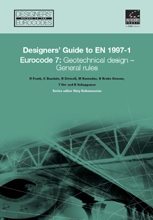Implications for UK practice
 Richard Driscoll, Peter Scott, and John Powell (2009), EC7 - Implications for UK practice, CIRIA C641, London: CIRIA, 126pp. Richard Driscoll, Peter Scott, and John Powell (2009), EC7 - Implications for UK practice, CIRIA C641, London: CIRIA, 126pp.
This book takes the reader through a logical sequence of activities, from site and ground investigation to geotechnical element design, to construction practices introduced by the new European Execution Standards and concludes with an indication of the likely timing of full implementation and a prediction of the effect that the changes will have on geotechnical practice in the UK.
The book seeks to give a clear overview of the main changes that will arise, adding in appendices such detail of the Eurocode system that is necessary to understand these changes. It illustrates the changes with a set of design examples covering mainstream design challenges such as piles, retaining walls, embankments and slopes, and hydraulic failure.
The book is authored by three specialists who have worked closely with the development and introduction of Eurocode 7 and its application in the design office, and the content has been carefully criticised by a panel of leading UK geotechnical practitioners.
Visit the publisher's website.
Decoding Eurocode 7
 Andrew Bond and Andrew Harris (2008), Decoding Eurocode 7, London: Taylor and Francis, 598pp. Andrew Bond and Andrew Harris (2008), Decoding Eurocode 7, London: Taylor and Francis, 598pp.
Decoding Eurocode 7 provides a detailed examination of Eurocode 7 Parts 1 and 2 and an overview of the associated European and International standards. Information scattered around the Eurocodes is collected into summary tables and diagrams. Extensive, fully annotated worked examples demonstrate how to apply Eurocode 7 to practical design situations. Flow diagrams explain how reliability is introduced into design and mind maps gather related information in a coherent framework.
Coverage includes:
- The Structural Eurocodes
- Basis of structural design and general rules for geotechnical design
- Ground investigation, testing, and characterization
- Verification of strength, stability, and serviceability
- Design of slopes and embankments, footings, gravity walls, embedded walls, piles, and anchorages
- Execution of geotechnical works
- Geotechnical reports
Written by authors who specialise in lecturing on the subject, Decoding Eurocode 7 explains the key Principles and Application Rules of Eurocode 7 in a logical and simple manner. Invaluable for practitioners, as well as for high-level students and researchers working in geotechnical fields, it shows how to apply the Eurocode to real designs.
Visit the book's website.
Designers' guide to Eurocode 7
 Frank R., Bauduin C., Kavvadas M., Krebs Ovesen N., Orr T., and Schuppener B. (2004), Designers' guide to EN 1997-1: Eurocode 7: Geotechnical design - General rules, London: Thomas Telford. Frank R., Bauduin C., Kavvadas M., Krebs Ovesen N., Orr T., and Schuppener B. (2004), Designers' guide to EN 1997-1: Eurocode 7: Geotechnical design - General rules, London: Thomas Telford.
Designers’ Guide to EN 1997-1 presents a detailed guide to the new Geotechnical Design Eurocode. As such it gives an invaluable insight into a code that, for the first time, provides a comprehensive design philosophy that is not only applicable to all forms of geotechnical problems but also shares a common philosophy with the design methodology for structures of all the commonly encountered construction materials.
Throughout, the book describes and explains the many unique features of ground engineering that require special design attention to ensure safety and adequate performance. Comprehensive checklists of aspects to be considered in design are given in Eurocode 7 and are emphasised in this book.
This guide is essential reading for: Civil and structural engineers Code-drafting committees Clients Structural-design students Public authorities. In fact, everyone who will be affected by the Eurocodes.
Visit the publisher's website.
|